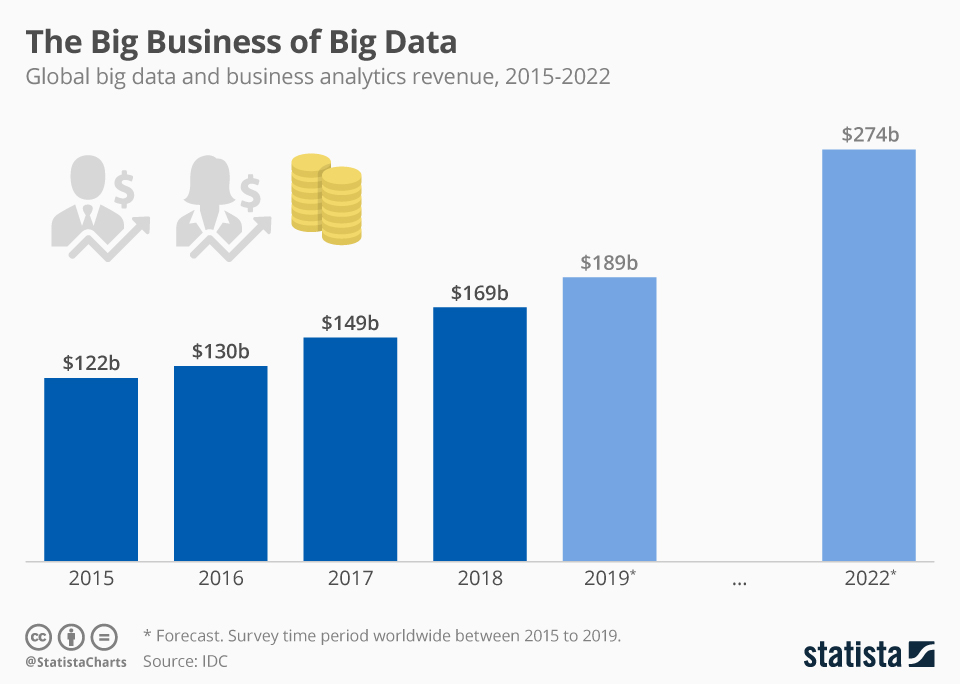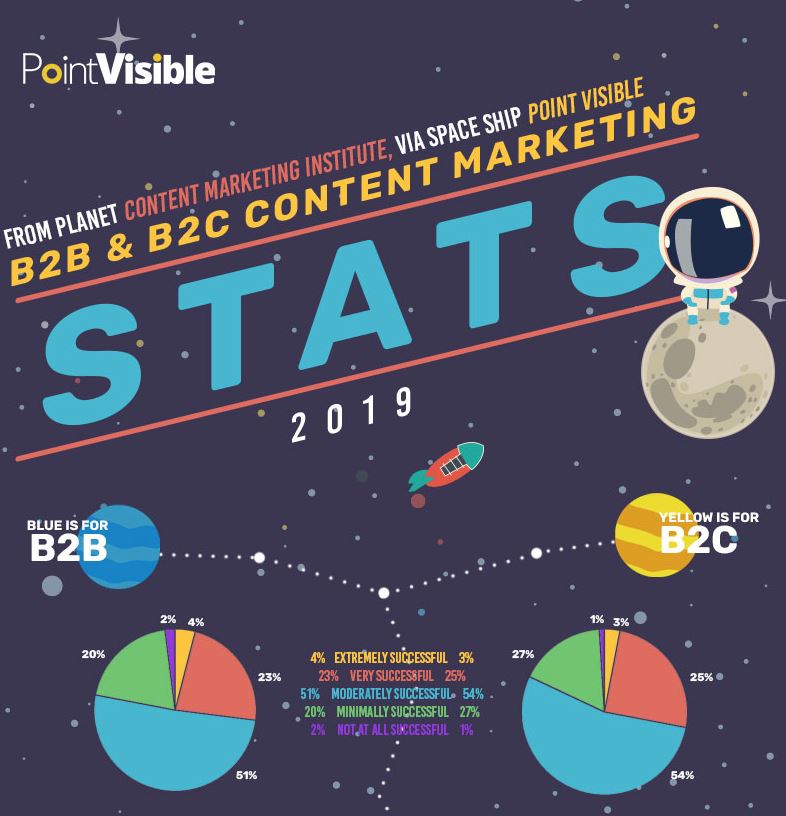There’s no point in us saying that ‘content is King’. We all know this. And practically all businesses are incorporating content marketing — in one form or another — into their promotional and advertising efforts.
The problem is that the content marketing landscape is changing… and we’re not keeping up.
Consider this. Content marketing statistics show that only around 30% of all marketers lead really successful content marketing campaigns.
Why is that the case, if we know that everyone is putting so much effort and trust into content marketing?
The answer is simple: they’re failing to adapt as the marketing landscape evolves.
With 2020 on it’s way, now is the perfect time to take a look at what parts of your content marketing strategy missed the mark in 2019.
Today we’ll explore emerging trends in content marketing that could help us all to create more effective strategies for the new year.
So let’s take a look at five ways to improve your content marketing strategy in 2020.
1. Performance Monitoring
Tracking key performance indicators… it seems like a no-brainer, right?
Yet according to the numbers, only around 50% actually measured their content marketing return on investment in 2018.
What’s particularly worrying about this is that it implies that some organizations could have been placing their time, money, and human resources into lengthy campaigns that weren’t achieving the desired result.
In 2020, there must be a greater focus on monitoring campaigns and tailoring them as deemed necessary.

Perhaps the reason why 50% of marketers don’t measure their success is that they think of content marketing as being more of a science than an art. It’s easily done.
After all, we’re beginning to understand a lot more about what works, and what doesn’t. But content marketing is an art.
There’s no hard and fast rule about what marketers should do, and it’s natural that they’ll be a little trial and error involved. Next year, brands should be working to monitor, track, reflect, and adjust their campaigns.
Here are some ways that make it easier to keep a close eye on the overall success of your campaign:
Analyze audience behavior on your site. Are your readers clicking through to other areas of your website, or taking some sort of action towards conversion, such as making an inquiry? If not, it suggests that the quality of your leads isn’t quite as good as it could be.
Determine your value.Tools such as Google Analytics can be useful in determining the sales ‘value’ of each page and, more importantly, the content on that particular page. These tracking tools help you to create a route map, highlighting which pages are responsible for making SQLs convert.
SEO and content.Analytics tools can also be used to show which pages are receiving traffic, and which aren’t. This works to highlight any aspects of your content that aren’t reaching out to your audiences or to search engines, and could suggest an SEO business/audience disconnect.
2. Big Data
The term ‘big data’ is everywhere, and yet most marketers still don’t understand what it is, or how it can be applied to a content marketing setting.
In a nutshell, big data is just that: it’s a huge amount of collected and collated data that a business holds about its audiences. It’s related to pretty much every interaction that an audience member has with a business, from clicks to communications, and everything in between.
Big data is such a big deal because of what can be done with this data.
Big data goes hand in hand with artificial intelligence, as we begin to use this data to predict future trends and behaviors. Brands have been investing in big data since 2015, and it’s expected to grow even more by 2022.

In content marketing data it holds the potential to do great things and is being cited as one of the key technologies to improve SEO ranking.
With the ability to collect, consolidate, and analyze customer information automatically, it’s possible that big data analytics could help marketers to identify trends and tailor their campaigns in response.
Big data is already being utilized by some of today’s most forward-thinking businesses. Mckinsey & Company estimates that around 44% of B2C marketers are using big data analytics to encourage better responses from audiences.
An additional 36% are understood to be using it to better understand customer behavior and generate more effective relationship-driven strategies. Overall, more than half believe that big data will be ‘essential’ for the marketing strategy of tomorrow.
Here are just some of the ways marketers could utilize big data in content marketing campaigns:
Use historical annual data to look at which sort of content attracts and engages with audiences the most throughout different times of the year. For example, long-form content may be more popular during winter months when people are spending more time indoors.
Similarly, we can use big data to gain a better understanding of what our audiences are searching for, and how aspects such as time of year can impact search terms. This enables marketers to tailor their SEO approach and create content that audiences want to see.
Big data can be used to look at associations between types of content. For example, it could show that audiences that are interested in this piece of content are also interested in that piece of content, which could be used to optimize the placement of internal links in articles.
3. CM Technologies
Content marketing technologies are becoming more widely available, and it is anticipated that, by next year, there will be even more accessible tools.
While 23% of brands are incorporating more technology into their campaigns. But don’t worry! We’re not talking full on robotics and complex artificial intelligence here. As Jacquie Chakirelis of the Great Lakes Science Center says, the role of AI and other new tech platforms is “blurry” and its impact on the relationship with the audience is not yet fully understood.
What we are talking about are automation tools which utilize aspects of AI to help marketers connect with the right people, generate topics of discussion that appeal, and really help content creators hone their skills.
According to the IDG report, ‘Technology Content Marketing 2019: Benchmarks, Budgets, and Trends’, some of the most commonly used CM technologies by today’s content marketers include:
- Social media analysis tools
- Email marketing software
- Automation software
- Workflow/project management software
- Content optimization tools
- Content management system (CMS)
- Promotional tools
- Chatbots
- Artificial intelligence

4. Real Time Content
The idea of ‘real-time’ is something that has already shown its value in the sales world. For example, real-time stock updates are already deemed to be the norm. Yet it’s something that hasn’t quite made its way fully over to the marketing sector.
This is all expected to change in 2020 as digital platforms begin to prioritize real-time, providing an increasing number of ways for content marketers to take advantage of this technology and engage with audiences during those ‘micro-moments’ when they want to buy.
Facebook Live is definitely the one to watch next year, especially with the updates that were rolled out in September 2019.
Facebook Live Video now allows marketers to ‘rehearse’ their content in advance to going live to test out interactive features and formats to ensure optimal levels of engagement.
In addition, the length of the broadcast has been doubled from 4 to a whopping 8 hours. Many of us watched this feature in use when NASA used their Facebook Live stream to show an 8 hour spacewalk!
Tools such as Facebook Live make it easier for marketers to tell their audiences a story, and make their content a little more interactive, which is something that’s hugely important right now.
Statistics show that only 52% of marketers use the concept of storytelling in their content. Surprising, given that the natural, inherent human process is to think in narrative, according to Marketing professor Susan Fournier.
In her Journal of Consumer Research paper, Consumers and Their Brands: Developing Relationship Theory in Consumer Research, she says that a ‘substantial amount of information stored in and retrieved from memory is episodic’. So why don’t you create content in an episodic way, too?
Here are some tips for getting real-time content marketing spot-on:
Set up Google Alerts so that you can stay on top of the latest trends, news, and announcements in your industry, and adopt an ABL (always be listening) approach.
Utilize commonly holidays and events into your content, such as holiday-themed content or content relating to widespread beliefs or trends with your target audience’s community.
As an alternative to tools such as Facebook Live, host a live Twitter feed during business events or throughout industry-related celebrations can provide valuable information for audiences.
Sales were once at the heart of communications, information sharing — and storytelling — is increasingly important at a time when consumers want to buy, but don’t want to be sold to. “I think most marketers still struggle with storytelling where the reader is the hero” says LinkedIn speaker Michaela Alexis.
5. Voice Optimization
By 2020, 50% of internet searches will be voice searches. which mean you’ll need to get in gear and start optimizing your content for voice.
While marketers have been optimizing content since Google’s Hummingbird update to coincide with the shift to Web 3.0, we’re still behind when it comes to voice specifically. At the Google I/O 2019 conference, keynote speaker Sundar Pichai, Google CEO, confirmed that 20% of all searches are already voice searches.

Both Web 3.0 optimization and voice optimization forces us to think more about how users are searching for content, and what they’re searching for. Long-tail keywords and conversational keywords will be more important than ever before next year, and marketers will need to consider speech patterns and localization when creating content.
Here are three tips for optimizing your content for voice searches:
Don’t think. Speak. Get vocal and take a closer look at what your audience would be using voice search for and how’d they be using it. Speak phrases as if you were your own audience.
Consider associated aspects that your audience may be including in their voice search. In a speech, it’s more likely they’d search for ‘restaurant in New York’ than just for ‘restaurant’.
Really think about context, and how a user’s voice search could be connected to other relevant searches. ‘Play center’, for example, could connect to other things to do with kids.
Summary
Here’s a quick recap of five ways to improve your content marketing strategy in 2020:
- Performance Monitoring
- Big Data
- CM Technologies
- Real Time Content
- Voice Optimization
Taking some time to consider these five aspects when planning your 2020 campaigns could not only help to make you a better content marketer, but actually help you to reach out to, and engage with, more audiences.
There is one thing that’s more important than anything else: solid documentation.
Here’s a statistic to make you laugh: 74% of B2C marketers and 78% of B2B marketers have a content marketing strategy. Great! But here’s the funny part… only one third actually think to write it down!
A content marketing strategy that’s being explored, but not documented, will likely end up being overlooked.
Explore the concepts above, try them, and document them. Create processes that will help you to achieve your goals, and which can withstand the demands of this rapidly changing environment.
About the Author

Deana Kovač is an internet marketing specialist at Point Visible, a digital agency providing custom blogger outreach services. In her free time, she enjoys listening to music and singing karaoke. Also, her day just can’t start without a hot cup of coffee.
Related Readings
